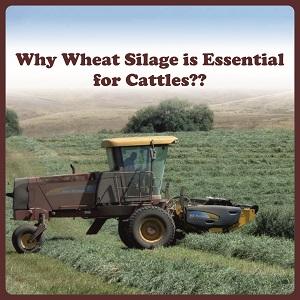Why Wheat Silage Is Essential for Cattles??

Wheat silage is one of the
most consumed cereals for cows and buffalos in the world. Along with corn and
rice, a situation that makes this food a basic ingredient for cattles. This is
an outstanding feed for growing cattle. In fact, wheat silage is not a modern
invention, but has been used in the past because of its properties and
effectiveness.
Milling and preparing wheat for consumption of
cattle
The wheat milling
process is done to remove the endosperm from the grain which is the part of
this food that gives rise to white flours. The grinding can also be done with
the peel along with the endosperm to create the whole flours, which are thicker
and have a higher nutritional value.
Dairy farmers are
switching from oat silage to wheat silage, made from a special plant. It has no
filaments on the cob, and is bringing benefits ranging from cattle health to
productivity. Wheat silage appears as the food base for cow and buffaloes
cattle. For beef cattle, wheat can replace corn as the main roughage. It is
necessary to balance the quantity of the cereal so that the cow does not lose
its productive capacity due to the deficiency of other nutrients.
What is the advantage of using wheat silage?
The great
advantage of using wheat silage is the fact that it is a winter crop, which
will not compete with summer crops, such as soybeans, corn and beans. Thus, the
opportunity arises to produce silage during the off-season, when there is
usually an area available for this. Some strength can be observed, such as-
·
Wheat silage is an energy feed that can replace corn
silage, both for dairy cattle and beef cattle.
·
It is possible to make direct cutting: in just one
operation, cutting, chopping, transportation and compaction are performed.
·
Compared to other crops such as barley, this makes
them support another drought.
·
Greater health, requiring less application of fungicides
and tolerating a lower quality soil than barley, which requires more.
·
It reduces the risk of food deficit for the herd.
·
Alternative of preserved food in times of food
shortage.
·
High nutritional value due to the relationship in
the production of grains and biomass.
·
Remains with green cover during the winter period,
helping to control weeds, pests and diseases, in addition to reducing the risks
of erosion.
Thus, it is
important for the producer to consider all these factors to see if its use fits
the objectives. Its cost will be slightly higher than corn. It is possible that
the benefits of these two crops (soy in the summer and wheat in the winter)
outweigh the benefits of making corn silage in the summer and pasture
in the winter.
Post Your Ad Here
Comments